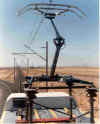As mentioned on the page related to the High Speed Current Collection Project, during the course of the project British Rail developed an experimental pantograph to enable the assessment of the dynamics of current collection (prediction and reality) to proceed.During the early stages of this work it became obvious to the engineers involved that neither the Faiveley
AMBR nor the GEC
(AEI) cross-arm pantograph, which were the two main pantographs in use on BR at the time, could be used in their standard
form for this type of experimental work. However, the Faiveley 'bicycle frame' pantograph
was thought to be the better of the two types and accordingly various modifications were carried out to
a pantograph including adding an extra arm and fitting air suspension but to no avail.
Help came in the shape of a little-known (at the time) firm in the West Country who dealt mainly in Rapid Transit pantographs. Brecknell, Willis were approached and persuaded to loan a pantograph to BR Research to 'play with'. This standard 'Highreach' pantograph was a compact lightweight example with spring suspension but little friction in the mechanism. Air suspension was fitted and an extra arm was added, as with the Faiveley before, but this time the results were more encouraging.
The final design for use at the test track gave outstanding results, so much so that it was soon recognised that here was a design which might be used 'in anger' to collect current at high speed or to give an acceptable performance on cheaper and dynamically inferior overhead equipment.







